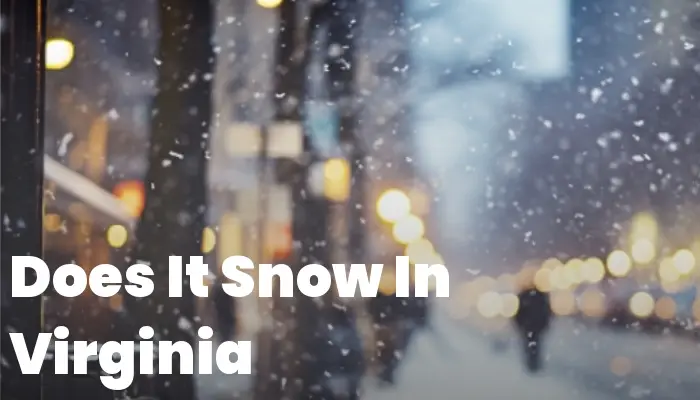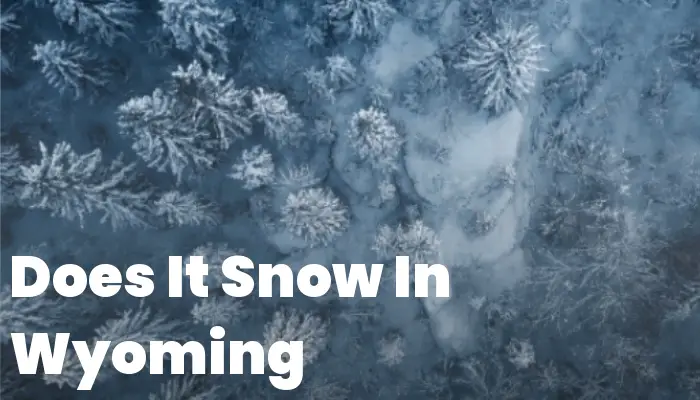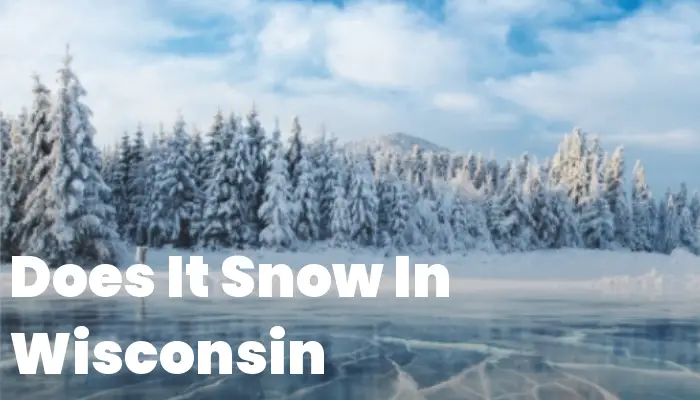Are you wondering about the winter weather in the Old Dominion State? Does it snow in Virginia? This is a crucial question for both residents and travelers alike. With its diverse climate, Virginia strikes a fascinating balance between mild coastal winters and chilly mountainous regions.
In this comprehensive overview, we will explore the fascinating weather patterns seen throughout Virginia, specifically focusing on its wintertime conditions highlighted by snowfall. From the Atlantic coastline to the Appalachians, you’ll gain insights into what to expect during winter in this wonderfully diverse state.
Does It Snow In Virginia?
The simple answer is yes, it does snow in Virginia. But the state’s weather is not one-size-fits-all due to its variable geography and climate. Virginia witnesses a range of winter weather patterns that can vary dramatically depending on where you are.
For those curious about the likelihood of experiencing a winter wonderland, pay close attention to the region within Virginia you plan to visit or reside in. The coastal areas, especially near the Chesapeake Bay and Atlantic Ocean, tend to see less snow due to milder temperatures influenced by the water. On the other hand, areas in Northern Virginia and those along the Blue Ridge Mountains, particularly at higher elevations, receive more substantial snowfall.
Cities like Norfolk or Virginia Beach might only see light dustings or occasional small accumulations that melt away quickly. Contrastingly, locations such as Charlottesville in Central Virginia, might expect moderate snow throughout the season. To fully understand what sort of snowy conditions one might encounter in this state, we’ll delve deeper into specific snowfall patterns next.
How Much Does It Snow In Virginia?
Virginia’s snowfall amounts are as varied as its landscape. Coastal regions generally see an average of 1-3 inches per year while Northern and Western Virginia, which include parts of Appalachia, witness a much heftier blanket of white ranging from 20 inches and up annually.
Major cities such as Richmond can experience seasonal averages between 10-12 inches but this can fluctuate yearly. The mountainous areas like Roanoke or Blacksburg are no stranger to significant accumulations—regularly seeing upwards of 20 inches each winter with certain places reporting even more prolific totals.
Taking a closer look at high-altitude regions exemplified by cities such as Harrisonburg or Winchester, residents prepare for deeper snowfalls often surpassing two feet over a season thanks to their proximity to colder air masses that sweep down from Canada and across the Appalachian Mountains.
Variability from Year to Year
Snowfall in Virginia is not just variable from region to region; it is also subject to change each year based on broader climatic conditions like La Niña or El Niño cycles. These phenomena can significantly influence temperature patterns and moisture levels—factors critical for determining whether precipitation will fall as rain or transform into blankets of snow.
Are There Ice Storms In Virginia?
Beyond just snowy landscapes, winter in Virginia can also bring about menacing ice storms—a combination of freezing rain that coats everything it touches with a slick layer of ice making travel hazardous and often leading to power outages due to downed trees and wires.
Central and Northern parts of the state are especially susceptible due primarily to their tendency for colder temperatures coinciding with wet weather systems moving through these areas during wintertime. Instances where temperatures hover around freezing during precipitation events set up perfect conditions for these treacherous ice coatings.
Historically speaking, significant ice storms have left lasting impacts on communities throughout Virginia necessitating preparedness each season among residents for potential disruptions caused by these icy disturbances borne from colliding warm moist air fronts with stubborn cold ground layers.
In conclusion, whether it’s fluffy flakes settling on Shenandoah Valley meadows or glaze ice glistening over Richmond sidewalks—winter in Virgina presents both challenges and splendor unique unto itself requiring both admiration for its beauty but respect towards its potential perils.
Just as with the question, Does It Snow In Virginia, each state in the United States has its own unique weather patterns.
For instance, if we consider states like Washington, West Virginia, and Wisconsin, we can see their individual climate differences.
In the article Does It Snow In Washington, it is noted that snowfall varies greatly depending on different regions within the state. Similarly, in West Virginia snow is a common occurrence during winter months as highlighted in Does It Snow In West Virginia.
On the other hand, Wisconsin experiences heavy snowfall due to its Northern location and proximity to two Great Lakes; this is detailed more in Does It Snow In Wisconsin.
Conversely, southern states like Alabama see little to no snowfall annually, which can be further explored in the article Does It Snow In Alabama.
Where Does It Snow In Virginia?
When considering where it snows in Virginia, the state can be divided into distinct climatic zones. Coastal Plains, Piedmont, Blue Ridge Mountains, and the Appalachian Plateau each present a different picture when it comes to snowfall.
The Coastal Plains experience mild winters with infrequent snow. However, moving inward to the Piedmont region, which includes cities like Richmond and Charlottesville, snow becomes more common though accumulation amounts are often moderate.
The Blue Ridge Mountains and areas further west towards the Appalachian Plateau are where you’ll find Virginia’s premier snowy destinations such as Wintergreen Resort in Nelson County or Massanutten Resort near Harrisonburg, which cater to winter sports enthusiasts thanks to their reliable seasonal coverings.
Norfolk and Hampton Roads on the coast may rarely see significant accumulations, whereas places like Roanoke tucked in the valleys of Southwest Virginia accumulate enough snow to disrupt daily routines and prompt occasional school closures. In these regions, local microclimates can cause considerable variation over short distances in terms of both temperature and precipitation.
Variability from Year to Year
Virginia’s weather patterns exhibit marked variability year on year owing not only to its geography but also due to influence from various climatic oscillations including the North Atlantic Oscillation (NAO) and Arctic Oscillation (AO). These factors can further complicate predictions for winter weather patterns across the state.
Virginia Roads and Winter Weather Conditions
Winter weather conditions pose particular challenges for transportation throughout Virginia. The Virginia Department of Transportation (VDOT) prepares rigorously for winter by pre-treating roads with brine before expected snowfalls, but road conditions during and after storms can still become treacherous.
Interstates such as I-81 that traverse through higher elevations are notably susceptible to closures from heavy snowfall or ice. Drivers in both rural areas and congested urban centers like Northern Virginia must remain vigilant for black ice—especially on bridges or overpasses which tend to freeze first due to cold air passing above and below these structures.
VDOT advises motorists to be cautious when traveling during winter months by keeping an emergency kit in their vehicles, maintaining a safe distance between cars, reducing speed accordingly, using headlights at all times for visibility purposes; essentially stressing defensive driving techniques during inclement conditions.
Snow Removal Efforts in Major Cities
Major cities within Virginiasuch as Richmond or Alexandria have comprehensive plans that prioritize key routes—ensuring main arteries remain passable even during heavier storms while secondary roads may take longer for plows and salt spreaders reach resulting temporary disruptions within local neighborhoods until cleared.
How Cold Does It Get In Virginia?
The coldness of a Virginian winter varies widely across its diverse landscape. Coastal areas benefit from the moderating effects of Chesapeake Bay and Atlantic Ocean generally enjoying milder temperatures even though they may dip below freezing occasionally.
In contrast central portions Piedmont experience cooler climate throughout season with average lows January hovering around 30 degrees Fahrenheit (-1 degrees Celsius). However true cold heart comes form mountain regions western part where night-time temperatures plunge well into twenties sometimes teens (-6°C below) highland blustery winds exacerbating chill factor creating biting cold sensations those exposed outdoors prolonged periods time.
Rural versus City Climate Differences: Even within same general area urban heat islands effect seen larger cities leading slightly warmer nights compared surrounding countryside reason why residents densely populated districts might note less frost than counterparts living outskirts town country settings.
To sum up yes it does indeed plenty places varying degrees intensity adds character challenge living traveling Old Dominion State whether you’re admiring serene snowy scenes preparing navigate icy thoroughfares having proper expectations respect nature crucial enjoying safely surviving wonders Virginian winters offer.
Snowfall in Virginia varies depending on the region, with some areas experiencing more wintry weather than others. When considering the coastal city of Virginia Beach, snow is not a common occurrence due to its milder climate; however, it does occasionally receive a light dusting. Moving inland, Newport News experiences slightly more snowfall, typically seeing a few inches each year.
As we look at the neighboring city of Chesapeake, residents there can also expect infrequent snow events but should still be prepared for when they do occur. Further into the Hampton Roads area, Norfolk shares similar snowfall patterns, with occasional winter weather that rarely becomes severe. On the other hand, as one ventures towards Virginia’s capital city of Richmond, there is an increased chance of substantial snowfall – offering a true seasonal contrast compared to its coastal counterparts.
In summary, while Virginia’s coastal cities may only see minimal snowfall annually, moving inland increases the likelihood and amount of winter precipitation experienced throughout the state.
Winter Activities In Virginia
When the temperatures drop and the snow begins to fall, Virginia transforms into a winter playground. If you’re looking for outdoor fun, the state offers a bounty of activities to embrace the season.
Skiing and Snowboarding are undoubtedly popular, with several resorts providing slopes suited for all levels of expertise. Wintergreen Resort and Massanutten are two prominent destinations where enthusiasts can hit the runs amidst stunning settings.
Snow Tubing is another family-friendly activity that has gained popularity in recent years. It’s a thrilling way to enjoy winter without requiring any special skills or equipment, other than a desire for excitement and perhaps a tolerance for some chilly splashes of snow.
For those who prefer quieter pursuits, Snowshoeing is an excellent way to explore Virginia’s scenic beauty. Trails in Shenandoah National Park offer breathtaking views of frosty forests and icy waterfalls.
Ice Skating is yet another winter staple, with rinks found in cities such as Richmond’s Stony Point Fashion Park or Pentagon Row Outdoor Ice Skating Plaza in Arlington—offering an urban twist on this classic frosty pastime.
Don’t forget about Festivals and Events—Virginia celebrates the season with various events like the Winter Wine Festival in Staunton or holiday markets throughout December that brim with local crafts and seasonal treats.
Cultural Indoor Attractions
When it’s time to warm up inside, Virginia doesn’t disappoint. The state boasts numerous cultural attractions from museums like The Virginia Museum of Fine Arts to historic theaters hosting plays, concerts, and more—a perfect respite from the brisk outdoor weather.
Winter Traveling In Virginia
Travelers planning a visit to Virginia during winter should be well-prepared for changing weather conditions that could impact their plans.
Road Safety: Always check road conditions before setting out—VDOT’s 511 service offers real-time traffic information. Also ensure your vehicle is winter-ready with good tires, a full tank of gas, and an emergency kit stocked with blankets, food, water, flashlight—and don’t forget a car charger for your phone!
Air Travel: Airports like Richmond International (RIC) or Washington Dulles (IAD) are well-equipped to handle wintery challenges but do expect occasional delays during storms; therefore it’s wise to monitor flight statuses closely around your travel dates.
Choosing Lodging: When booking accommodations consider proximity to main roads which might be cleared faster than remote areas after heavy snowfall thus offering better access even when conditions are less than ideal.
Remember that flexibility can be key during winter travel; sometimes last-minute plan changes are necessary due to Mother Nature’s whims so having travel insurance might be beneficial as it provides extra peace-of-mind.
Tips For A Smooth Journey
Allow extra time for all journeys whether driving flying even taking trains buses within state due unpredictable weather patterns always better err side caution when dealing potential delays disruptions caused by snow ice.
The Warmth After The Snow: Enjoying Virginian Hospitality During Winter
After enjoying all sorts of cold-weather adventures—or perhaps instead—a great way immerse oneself local culture savor some Southern hospitality cozy up one many charming bed breakfasts enjoy regionally inspired cuisine fireside renowned restaurant just spend evening sipping craft beverages local winery brewery distillery.
Virginians know how make most every season there something truly special about warmth community spirit shines through even chilliest days.
Whether spending action-packed day slopes simply relaxing enjoying tranquil snowy landscapes embrace unique seasonal offerings that come life across diverse beautiful Virginian landscape.
So pack bundle layers ready adventure because experiencing magic Virginian winter something cherish forever!
With its array opportunities exploration relaxation no reason not fall love Old Dominion State this time year so come discover why even cold months hold their own brand enchantment here magical place called Virginia.


